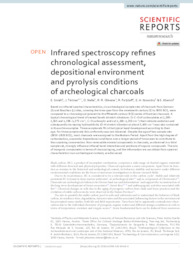Infrared spectroscopy refines chronological assessment, depositional environment and pyrolysis conditions of archeological charcoals.
Infrared spectroscopy refines chronological assessment, depositional environment and pyrolysis conditions of archeological charcoals.
Autoria: SMIDT, E.; TINTNER, J.; NELLE, O.; OLIVEIRA, R. R.; PATZLAFF, R.; NOVOTNY, E. H.; KLEMM, S.
Resumo: Based on infrared spectral characteristics, six archeological sample sets of charcoals from German (5) and Brazilian (1) sites, covering the time span from the nineteenth century CE to 3950 BCE, were compared to a chronological (present to the fifteenth century BCE) series of Austrian charcoals. A typical chronological trend of several bands (stretch vibrations: O-C-O of carboxylates at 1,585-1,565 and 1,385-1,375 cm(-1), C-O carboxylic acids at 1,260-1,250 cm(-1)) that indicate oxidation and subsequently increasing hydrophilicity (O-H stretch vibration at about 3,400 cm(-1)) was also contained in the archive samples. Three sample sets fit in the typical band development according to their age. For three sample sets this conformity was not observed. Despite the age of two sample sets (3950-2820 BCE), most charcoals were assigned to the Modern Period. Apart from the high degree of carbonization, anaerobic depositional conditions over a longer period of time seem to contribute to the surprising conservation. Non-removable mineral components in charcoals, as observed in a third sample set, strongly influence infrared band intensities and positions of organic compounds. The role of inorganic components in terms of charcoal aging, and the information we can obtain from spectral characteristics in an archeological context, are discussed.
Ano de publicação: 2020
Tipo de publicação: Artigo de periódico
Unidade: Embrapa Solos
Palavras-chave: Biochar, Matéria Orgânica, Soil organic matter, Solo
Observações
1 - Por padrão são exibidas publicações dos últimos 20 anos. Para encontrar publicações mais antigas, configure o filtro ano de publicação, colocando o ano a partir do qual você deseja encontrar publicações. O filtro está na coluna da esquerda na busca acima.
2 - Para ler algumas publicações da Embrapa (apenas as que estão em formato ePub), é necessário ter, no celular ou computador, um desses softwares gratuitos. Sistemas Android: Google Play Livros; IOS: iBooks; Windows e Linux: software Calibre.
Acesse outras publicações
Acesse a Base de Dados da Pesquisa Agropecuária (BDPA) para consultar o acervo completo das bibliotecas da Embrapa.

